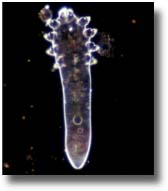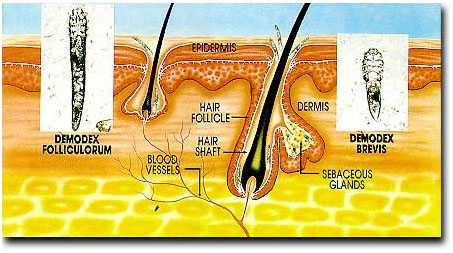Is human Demodex effecting your
skin?
Human Demodex
 Did you know that demodex, a little-known
parasite, has been widely living parasitically in the skin of humans
and animals since the existence of life? It could be said that,
where there are humans and animals there is demodex. It lives in
human and animal hair follicles and sebaceous glands. It can pass
through hair follicle pores freely, feeding on endoplasm. It can
pass through hair follicle pores freely, feeding on endoplasm in the
hair follicles and sebaceous glands. It reproduces very fast, with
one generation in about 14 days. Its scientific genus is Demodex. It
travels through the hair follicles and was first discovered in the
hair follicles. Thus it is also known as hair follicle mite. Did you know that demodex, a little-known
parasite, has been widely living parasitically in the skin of humans
and animals since the existence of life? It could be said that,
where there are humans and animals there is demodex. It lives in
human and animal hair follicles and sebaceous glands. It can pass
through hair follicle pores freely, feeding on endoplasm. It can
pass through hair follicle pores freely, feeding on endoplasm in the
hair follicles and sebaceous glands. It reproduces very fast, with
one generation in about 14 days. Its scientific genus is Demodex. It
travels through the hair follicles and was first discovered in the
hair follicles. Thus it is also known as hair follicle mite.
Demodex - The revolutionary find in
dermatology
 97.68% Yes! A starting 97.68% of human
adults unknowingly have on them very parasitic natured mite known as
'Demodex' (a hair-follicle mite). This information might surprise
you, but the figures are derived from Dr. Qu Kui Zun's worldwide
clinical observations and epidemiological studies over a 48 years
period, between 1955 till today. His three decade long study
involved a total number of 905,801 participants, of various races,
ages and occupations. 97.68% Yes! A starting 97.68% of human
adults unknowingly have on them very parasitic natured mite known as
'Demodex' (a hair-follicle mite). This information might surprise
you, but the figures are derived from Dr. Qu Kui Zun's worldwide
clinical observations and epidemiological studies over a 48 years
period, between 1955 till today. His three decade long study
involved a total number of 905,801 participants, of various races,
ages and occupations.
What damage can DEMODEX do?
 Demodex Folliculorum pokes into hair follicles,
sucks out the nutrients and those at the root of the hair.
Consequently, the hair follicles become enlarged and infected. The
final result is hair loss and inflammation of the surrounding
tissue. Demodex Brevis feeds on the nutrients in the sebaceous
glands. Demodex Folliculorum pokes into hair follicles,
sucks out the nutrients and those at the root of the hair.
Consequently, the hair follicles become enlarged and infected. The
final result is hair loss and inflammation of the surrounding
tissue. Demodex Brevis feeds on the nutrients in the sebaceous
glands.
As a result, the sebaceous glands become infected
and inflamed i.e. poliferated. But, when both the Demodex are
present, the damage can be substantial. Demodex breeds and multiples
fast (2 weeks) and as a result of which causes the pores to enlarge
leaving the skin rough and even inflamed. Acne Rosacea is therefore
caused by increasing Demodex activity.
Do I have DEMODEX?
If your skin is rough and has a tendency to flush around your
facial region or there is considerable hair loss, then there is a
strong possibility that there is DEMODEX activity.
How do I have DEMODEX?
Dr. Qu Kui Zun invented the 'Sebum Quantifying Instrument' by
which the squeezed sebum (from skin) was put under the microscope to
examine the density as well as the quantitative diagnostic criteria.
 Human demodex is distributed all over the
world, commonly living in the hair follicles and sebaceous glands of
human beings. From the evolutionary viewpoint, its ecological
relationship with man can be traced back to primitive times. It may
have already co-existed with man and animals since early times and
has since adapted to man's later development and survived until
today. Demodex has its unique adaptation in its evolution. This
adaptation requires it be guaranteed a niche in the host's body it
infests. Therefore, a fixed infesting position (specific location)
and a constant food source as well as a corresponding unique
transmitting mode (transmission mechanism) are needed. Human demodex is distributed all over the
world, commonly living in the hair follicles and sebaceous glands of
human beings. From the evolutionary viewpoint, its ecological
relationship with man can be traced back to primitive times. It may
have already co-existed with man and animals since early times and
has since adapted to man's later development and survived until
today. Demodex has its unique adaptation in its evolution. This
adaptation requires it be guaranteed a niche in the host's body it
infests. Therefore, a fixed infesting position (specific location)
and a constant food source as well as a corresponding unique
transmitting mode (transmission mechanism) are needed.
In its long evolutionary adaptation, the human demodex, which
infests the long cavity hair follicles and short cavity sebaceous
glands of humans, has formed two species with differing
characteristics, one with an elongated body and the other with a
short one. These unique habitats - hair follicles and sebaceous
glands - are their best surviving niches. They are bisexual,
copulating the follicle openings and reproducing in their infesting
territories. They transmit through close contact of the host and
survive generation after generation.
Human Demodex has no intermediate host.
It passes its whole life in the hair follicles and sebaceous
glands of man. It is bisexual and reproduces through intercourse at
the openings of hair follicles, after which it goes back to
surrounding hair follicles and sebaceous glands to lay eggs and
reproduce.
A sample survey conducted of 902,505 people has
shown the following results: demodex has been detected on the faces
of a staggering 97.68% adult males and females.
There are no
national, racial, regional, climatic, occupational and sexual
differences in demodex infestation in humans. Since the infestation
rate of demodex (qualitative determination ) cannot be used to
analyze it, the infectiosity of demodex (quantitative determination)
should be used to explain it.
| 


